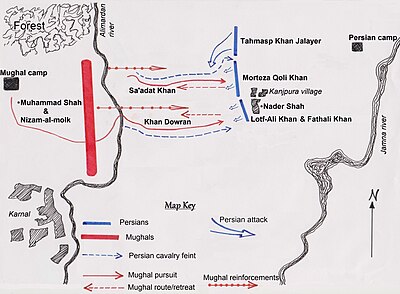Battle of Karnal
The Battle of Karnal, fought on February 24, 1739, marked decline in the Mughal Empire. Nadir Shah, the Iranian ruler, decisively defeated Mughal Emperor Muhammad Shah ‘Rangila’ in a matter of hours. This battle not only showcased the military prowess of Nadir Shah but also exposed the vulnerabilities of the Mughal Empire, leading to its eventual downfall.
Background of the Mughal Empire
The Mughal Empire reached its zenith under Emperor Aurangzeb but began to decline after his reign. Factors contributing to this decline included internal strife, heavy taxation on peasants, and military challenges from various regional powers. The empire faced revolts, which strained its resources and weakened its authority.
Nadir Shah’s Invasion
Nadir Shah, having consolidated power in Persia, sought to expand his territory. After conquering Kandahar in 1738, he aimed for India. His invasion began in late 1738, and he swiftly overcame several Mughal vassal states. The Mughal response was slow and ineffective, demonstrating the empire’s declining efficiency.
The Battle of Karnal
The two armies met at Karnal, with the Mughals fielding a massive force of 300,000 soldiers, including elephants and cannons. In contrast, Nadir Shah commanded a smaller, more disciplined army of 55,000. His strategic superiority and modern tactics led to a swift victory over the Mughals.
Aftermath of the Battle
Following the battle, Nadir Shah marched into Delhi, plundering the city and massacring thousands of its inhabitants. The wealth taken from the Mughal treasury included the famous Peacock Throne and the Koh-i-noor diamond. Although Nadir Shah returned some territories to Rangila, the Mughal Empire was left severely weakened.
Long-term Consequences
The defeat at Karnal and the subsequent sacking of Delhi marked the beginning of the end for the Mughal Empire. Although the Mughals continued to rule for another 118 years, their authority diminished . The empire gradually lost territory and power until its eventual dissolution by British forces in 1857.
Month: Current Affairs - February, 2025
Category: Art & Culture Current Affairs








